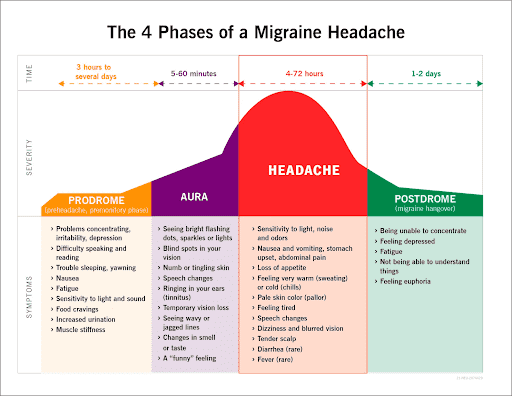
When people hear the word “migraine,” they think it’s just a severe headache or pain slightly more than a throbbing sensation in the temples. However, there are differences between the two that are important to note.
What is a migraine?
A migraine is more than a headache; it’s a neurological condition affecting more than one billion individuals yearly. Its most notable aspect is a pulsing headache on one side of the head, but it’s common to have a migraine without this pain. Other symptoms include aura, ringing in the ears, neck or shoulder pain, nausea, light or sound sensitivity, and irritability. Aura is a mixture of sensory, motor, and speech symptoms that act as warning signals before a migraine attack begins. About 15-20% of people experience migraine with aura.
There are four stages of a migraine attack. The first is prodrome, also known as preheadache, which can last a few hours to a few days. Symptoms include difficulty concentrating, speaking and reading, and moving muscles. The second is aura; this is the stage that some people may skip. The third is attack. Its main feature is a headache, and symptoms mimic an illness (nausea, loss of appetite, chills or sweating, dizziness). The last is post-drome, also called a migraine “hangover,” as its symptoms are similar to one: aches, mental fog, and feeling physically drained.

How are the dealt with?
Unfortunately, very little is known about what triggers a migraine. The best way to deal with a migraine is to avoid it in the first place: if you can figure out its triggers, then avoid it.
Common triggers include drugs like alcohol and caffeine, stress, bright lights, strong smells, and a lack of sleep. Genetics also plays a significant role. About 60% of people have migraines because they inherited it.
If over-the-counter medicines like Advil Migraine or Excedrin Migraine don’t work, doctors can prescribe sumatriptan or rizatriptan. Both block pain pathways in the brain.
In general, hunkering down in a quiet, dark place and resting is the best way to deal with migraine pain. While there’s a common misconception that migraines are just more painful headaches, they are much more than that and should be taken seriously. As you would with any illness, do what you must do to feel better.

Sources:
https://www.pennmedicine.org/updates/blogs/health-and-wellness/2019/november/migraines-vs-headaches
https://www.ncbi.nlm.nih.gov/pmc/articles/PMC8904749/#:~:text=Migraine%20affects%20more%20than%20one,among%20young%20adults%20and%20females
https://my.clevelandclinic.org/-/scassets/images/org/health/articles/5005-migraine-headaches.jpg
https://www.mayo.edu/research/centers-programs/migraine-research-program/overview#:~:text=Migraine%20is%20challenging%20to%20study,the%20disorder%20as%20a%20disease
https://www.verywellhealth.com/thmb/CHtrxODCBCw9pmMDeotVPi-I7fI=/1500×0/filters:no_upscale():max_bytes(150000):strip_icc()/brain-lesions-on-mri-in-migraines-4044746-5c93cd0646e0fb00014427d0.png


Add a Comment